Remembering Maui’s Filipino Veterans
Including Unsung Heroes Maui Volunteers
Alfredo G. Evangelista | Assistant Editor
Veterans Day will be celebrated on November 11. The federal holiday honors military veterans of the United States’ armed forces (Army, Air Force, Navy, Marines and Coast Guard). It was first celebrated as Armistice Day after World War I and expanded after World War II to include WWII veterans and renamed “Veterans Day.”
Filipinos were instrumental in World War II and subsequent American wars and conflicts. During World War II, my Dad Elias Acang Evangelista, living in Paoay, Ilocos Norte, joined the guerrilla forces against the Japanese occupation forces. The Japanese attacked Manila and invaded the Philippines following the Pearl Harbor bombing and Filipinos fought hand to hand combat against the Japanese military throughout the remainder of the Pacific War. My Dad never really shared his war time stories so I can only vaguely recount how my Dad’s relatives assisted my eighteen-year-old Mom to hide from the Japanese army, who as we now know, were capturing females in occupied territories to be comfort women.
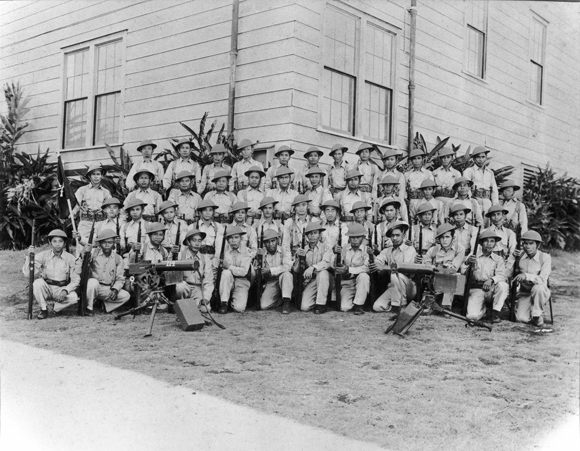
Photo Courtesy A&B Sugar Museum, reprinted in Anak
During World War II, President Franklin Delano Roosevelt urged Filipinos to join the United States in its war against Japan, with the promise of U.S. citizenship to those who fought. At that time, the Commonwealth of the Philippines was a U.S. Territory. Thousands, including guerrillas and members of the Philippine Army, joined the Americans in fighting the Japanese. Unfortunately, in 1946 Congress passed the Rescission Act which canceled Roosevelt’s promise. Sixty-three years later, President Barrack Obama signed into law a 2009 bill awarding the Congressional Gold Medal and cash ($15,000 to citizens and $9,000 to non-citizens) to these Filipino veterans, a rather small token of American recognition for their wartime service. Much has been written about these Filipino veterans.
Filipinos also actively supported the war effort on the home front. Filipinos residing in the United States and Territory of Hawai‘i volunteered for duty. Initially, Filipinos, as non-citizens, were not allowed to be part of the U.S. armed services. On December 20, 1941, President Roosevelt changed the selective service law, leading to the creation of the 1st and 2nd Filipino Infantry to allow Filipinos to serve in World War II. The 1st and 2nd Filipino Infantry Regiment were highly decorated and included future stars in Hawai‘i’s political and community future: Associate Supreme Court of Hawai‘i Justice Benjamin Menor, State House of Representatives Vice Speaker Emilio Alcon, Representative Peter Aduja, Department of Education District Superintendent Domingo Los Baños, Pearl of the Orient Dance Troupe co-founder Orlando Valentin and many others. (The Americans of Japanese Ancestry/Nisei 442nd and 100th Battalion Regimental Combat Team received more renown than the Filipino units and after the War, returning Japanese veterans are credited with forming with local agricultural worker unions—largely Filipinos—a foundation for the Democratic Party’s political base that eventually overthrew the power of the local Republican sugar and pineapple plantation owners.) A documentary titled An Untold Triumph can now be seen on youtube.com/watch?v=pU-kSnAXu7s. My cousin Dr. Linda A. Revilla, an Associate Producer of the documentary, has written about the experiences of the 1st and 2nd Filipino Infantry.
(My favorite 1st and 2nd Filipino Infantry Regiment story comes from my time as a Law Clerk/Extern at the Supreme Court of Hawai‘i in the Fall of 1982. A day or so after the General Election that year, all the Law Clerks and Justices gathered in the Chambers of Chief Justice William Richardson. The occasion was to celebrate one of the Justices’ birthday although another Justice joked he thought it was to talk about the election. During the birthday celebration, Chief Justice Richardson began reminiscing about his time as a member of the 1st and 2nd Filipino Infantry Regiment with Justice Menor. Richardson and Menor were assigned to the southern part of the Philippines. Richardson told the story about how one weekend he and Menor—I can’t remember now if there were others—hijacked or “borrowed” a jeep and went gallivanting, apparently without permission. Richardson’s eyes smiled and he laughed when he told the story and he made sure to mention that whatever rank they lost for their cruising was quickly earned back.)

Photo courtesy Louise Smith reprinted in Anak
After World War II, Filipinos from Hawai‘i continued to enlist in the armed forces, serving during the Korean and Vietnam Wars. My late brother Rogelio Evangelista who was in the U.S. Air Force claims he had a Top-Secret position and would take day trips to Vietnam to observe the ongoing drug situation there. (Being that it was a top-secret mission, there are no records of Roger going to Vietnam and he could not file for any Agent Orange damages as his official service records indicate he was painting houses at the air force base in New Mexico on the days he claimed he was on his classified mission.)
More Filipinos from Hawai‘i would serve during the Iran/Iraq crisis, including my cousin Jimbo Evangelista, who remains active as a Staff Sergeant with the Hawai‘i Army National Guard. Many other Filipinos are currently serving with the Hawai‘i National Guard, including Captain Aris Banaag with the Hawai‘i Air National Guard. During the height of the pandemic, the Hawai‘i National Guard was a great assistance on various levels. For example, they assisted with various food drives, including Binhi at Ani’s Bayanihan Food Distribution. The National Guard also assisted with various vaccination clinics such as Bakuna at Binhi at Ani Filipino Community Center.
Without a doubt, local Veterans (and active military personnel) deserve our thanks and recognition this Veterans Day and for that matter, every day.
But little has been written or recounted about the Maui Volunteers. A Google search practically comes up empty. Anak, the Commemorative Book published by Maui’s Filipino Centennial Committee chaired by Vince Bagoyo, Jr. contains two large photos of the Maui Volunteers but without much explanation. The 75th Anniversary Souvenir Booklet published by the Maui 75th Anniversary Committee chaired by Raquel Nancy Andres contained three photos of the Maui Veterans with a couple of explanatory paragraphs. In 1946, Celedonio Asuncion wrote and published a hardbound book titled Souvenir Manual of Hawai‘i Filipinos (“Manual”). The Manual contained over 130 pages of biographies and photos of Filipinos titled “Maui Graphical Life Sketches” which included the names and photos of over 275 Maui Volunteers. But that list was incomplete (a few prominent names were glaringly absent) and the Manual doesn’t provide any background of how and under what circumstances the Maui Volunteers were created.
Asuncion, in his Introduction and Dedication to the Manual notes: There is a crying need for a souvenir that is simple but dear to the heart of every Filipino—Filipinos here, at home, and abroad, who tasks have contributed to the winning of our victory, security and peace. The publication of this book is the answer to this demand, and in memory to the unsung heroes—the unknown soldiers who gave up their lives that we might live; to the common man whose patriotism, loyalty and productive effort, holds lovely memories of plantation life.

The phrase “unsung heroes” aptly describes the Maui Volunteers (See above for a partial list). They were not awarded veteran status because they were never activated. But they served a key role in helping to guard and protect Maui. (After the bombing of Pearl Harbor, the National Guard of Hawai‘i was federalized and the Hawai‘i Territorial Guard was created.)
Brig. Gen. Charles B. Lyman was key to the formation of ten regiments of volunteers throughout the Territory of Hawai‘i which became known as the Organized Defense Volunteers. The Maui Volunteers were organized in March 1942, commanded by Colonel E. Percy Lydgate.
But even before the formal organization of the Maui Volunteers, Oriental Benevolent Association (OBA) president and manager Philip P. Gamponia, organized a militia of Filipino men. Under Gamponia’s leadership, Filipinos began para-military drills. Gamponia was a pure civilian—without any military training.
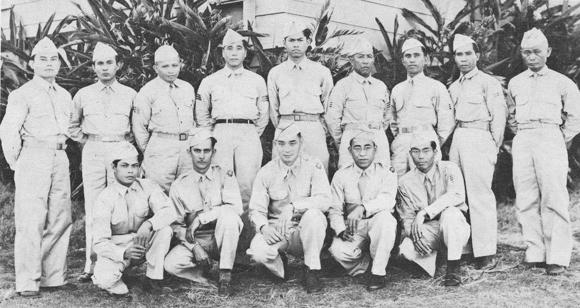
Photo courtesy David Cup Choy, reprinted in 75th Anniversary Souvenir Booklet
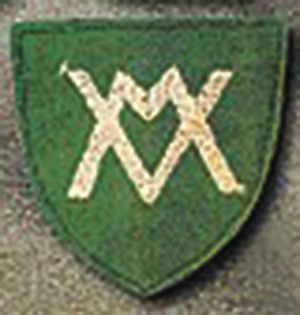
Capt. David A. Cup Choy of Company L, 3rd Battalion, 1st Regiment of the Maui Volunteers wrote “99 percent of the men are Filipinos. They were prepared to defend Hawai‘i in case of invasion. They were also assigned to guard vital installations such as power plants, pumping stations and water sources.” The Maui Volunteers’ mission boiled down to guarding vital installations, maintaining peace and order in the camps and plantations, serving as traffic control officers, and supporting regular military units as a reserve in event of an emergency.
The army in April 1942 officially sponsored the regiments and issued the army’s regulation khaki uniforms, which were purchased by the members or their sponsors—the plantation or a business. The Maui Volunteers had their own patch—an MV monogram. The Maui Volunteers were trained by army officers, ate army food and wore army fatigues. They served without any compensation.
Cup Choy wrote: “All attended weekend drilling with regular Army men assigned to each company for three and a half years.” The training would be held over three weekends each month. Training would be at various sites around the island, including Waihe‘e Park (now renamed as Richard Pablo Caldito, Sr. Park). Caldito served as a Sergeant in the Maui Volunteers.
Lolita Sevilla Eugenio recalls her Dad, Sgt. Asisclo B. Sevilla mentioning the volunteers undergoing basic drills on a regular basis to be ready. Her sister Linda Sevilla Kushi says “Until we ‘found’ Dad’s helmet during our grade school years, we did not know he served with the Maui Volunteers nor did he say much about his time with the group. The hard hat was used by us as a prop when playing!”
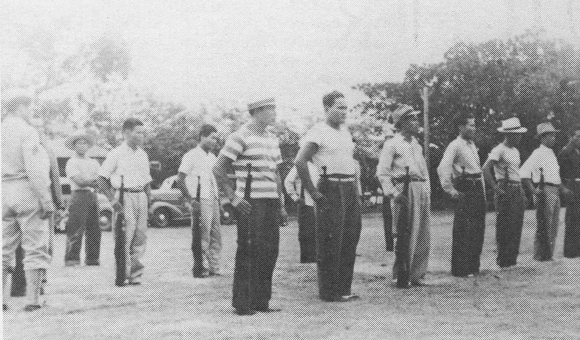
Photo courtesy Lucas Reyes reprinted in 75th Anniversary Souvenir Booklet
An October 13, 1942 message from Brigadier General R.E. Mittelstaedt stated: The American System of repelling an invasion has always leaned heavily upon the home guard or part time soldier. In this District we have the Maui Volunteers consisting of Infantry and Cavalry units. These units are made up of residents of the District who help to produce such vital commodities as sugar, pineapple, cattle, etc., which are all necessary for carrying on and winning the war. On their own time they train to defend your home and their home here on these islands. The Maui Volunteers are a very definite and important factor in the defense of these islands. They will become, in event of an emergency, a part of the Armed Forces of this district. In view of this responsibility, it behooves the government to properly equip and train them for the duties to which they will be assigned. It is the responsibility of the public to give them the utmost support. As District Commander, I express great appreciation for the support already given and of the splendid interest evidenced by the volunteers themselves. Within the means placed at my disposal, I will exert every effort to have these men trained as an effective force.
Full support from the Army, however, was not immediate. The Maui News reported each member of Company M, 3rd Battalion (representing Hāli‘imaile) was armed with a bolo knife made by the volunteers themselves in Maui Pineapple Co.’s blacksmith shop. Catalino Cachola from Narvacan, Ilocos Sur, was a Maui Volunteer at Spreckelsville. Although his wife Veronica who he married in 1969 was never fully aware of her husband’s activities with the Maui Volunteers, she still has that long bolo knife. Eventually, all members of the Maui Volunteers were equipped with a .30-caliber infantry rifle. Raymond Cabebe recalls his Dad Rafael Cantorna Cabebe, also from Narvacan, Ilocos Sur, as being very proud of serving. Sgt. Cabebe was in the Headquarters Company and kept his M1 rifle “which hung in our hall closet at our home on Lono Avenue for many years until my brother Jimmy took it after Dad got sick with Parkinsons.”

Photo courtesy Souvenir Manual of Hawai‘i Filipinos
As Cup Choy noted, a high percentage of the Maui Volunteers were of Filipino ancestry. These Maui Volunteers were Sakadas who came to work in the plantations in the 1920’s. The Manual identified Juan Ballesteros of Dingras, Ilocos Norte as first arriving in Hawai‘i in 1907, where he was assigned to O‘ahu Sugar in Waipahu. In 1910, he took a vacation to the Philippines and returned to Hawai‘i in 1930, working at Maui Pineapple Company at Haleakalā Camp in Makawao. He moved to Pu‘unēnē in 1933, living at Young Hee Camp and worked at the Pu‘unēnē mill.
Two other Maui Volunteers were identified by the Manual as arriving in 1910. Staff Sgt. Victor E. Imperial and Private Felomeno Lopez. Imperial was from Masinloc, Zambales and initially assigned to the Maui Agricultural Company and later transferred to the Kahului Railroad Company and then Baldwin Packers Limited in Lahaina. Lopez from Infanta, Tayabas was nine years old when he came to Hawai‘i with his uncle. He became a blacksmith at the Volcano Stable on Hawai‘i island and later at Hilo Railroad Company. When Felomeno came to Maui, he operated his own business and later became a butcher at Chun Wa Butcher Shop in Lahaina. In 1924, Lopez operated his own fishing sampan.

Photo courtesy Souvenir Manual of Hawai‘i Filipinos
As primarily Sakadas, members of the Maui Volunteers came from all the Philippines, including my Dad’s hometown of Paoay in the Province of Ilocos Norte. The three Nefulda brothers who were living at Camp 2 in Spreckelsville were all members: Staff Sgt. Ciriaco, Private First Class Lucio and Private Luis. Ciriaco was a noted marksman and participated in the Regimental Rifle Matches in 1944 and the Inter-Island Inter-Regiment Rifle Matches in 1945. Ciriaco was awarded a sharpshooter medal in 1944 and a marksmanship medal in 1945. Like many others who served in the Maui Volunteers, Ciriaco and his brother Luis were awarded the Volunteer Service Ribbon on July 4, 1945.
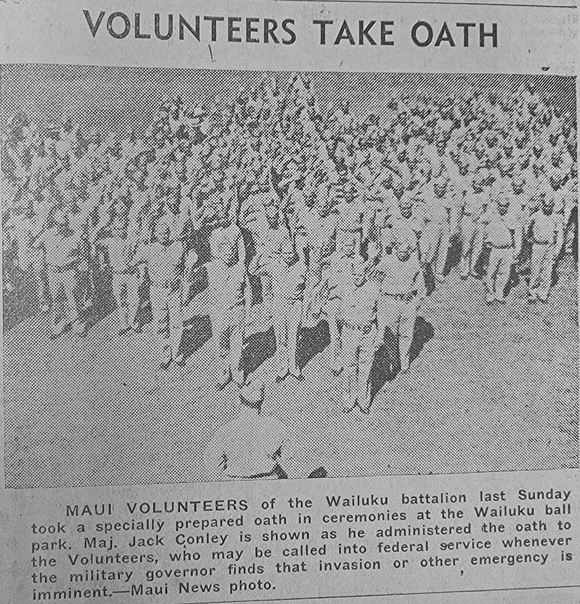
Photo courtesy Maui News archives
Throughout the island, Maui Volunteers began taking their special oath of allegiance. The Wailuku battalion members took their oath on September 20, 1942. But there was still a need for more members and ads were placed in the Maui News encouraging men to join the Maui Volunteers by contacting their local commanders in Waikapū, Wailuku, Spreckelsville, Pā‘ia, Lahaina, Hāna, Pu‘unēnē, Hāli‘imaile and Waihe‘e.
Even the Chairman and Executive Officer of the Board of Supervisors, Al S. Spenser, wrote a message encouraging men to volunteer: There is a Drive on at the present time calling on all male citizens who can qualify, to join the Maui Volunteers, a strictly civilian organization whose main purpose is to assist the Military in times of great emergency. This Drive to increase the number of volunteers is one that should be given favorable consideration by the citizens of this County. I am heartily in accord with the Drive and urge you to enlist at once. With World conditions as they are today, it behooves us all to be prepared at all times. The Army is cooperating to the fullest extent by training the volunteers and furnishing them with the proper Army equipment. This is done in order to better prepare you to do your part in defending your country, home and loved ones. The people of Maui County have never failed to respond to a cause such as this and have always lived up to it’s motto, ‘MAUI NŌ KA ‘OI. Think of what our boys are doing in all parts of the World and enlist at once.
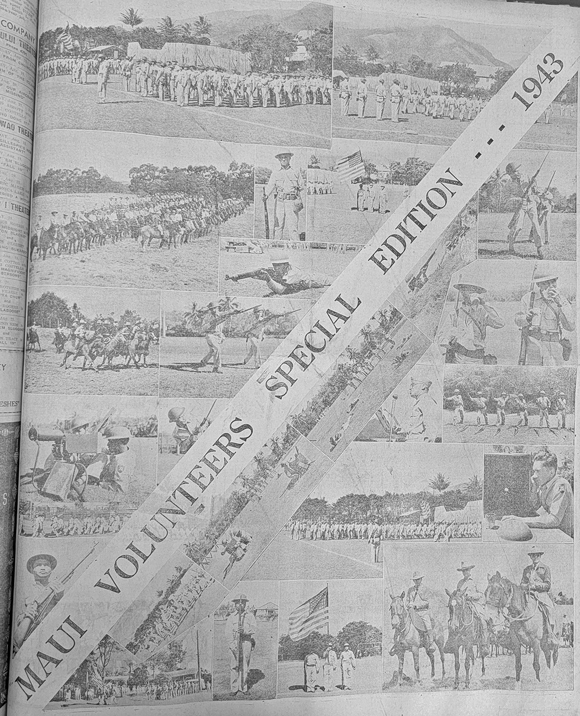
Photo courtesy Maui News archives
Maui residents and the business community were initially wary of organizing military units from the plantation, largely Filipino, workforce. The Maui News reported Commander Lydgate in addressing members of the Maui Rotary Club in August 1942, assured his audience the Maui Volunteers were not “combatant troops.” Instead, Lydgate explained, “Members of the Volunteers has taken an oath which gives them belligerent rights in case of an invasion and they may be called out, though not inducted into the army, at any time prior to an actual invasion.” Lydgate felt the need to pay “high tribute to the loyalty and zeal of Filipinos” according to the Maui News, saying “If the Filipinos are treated right and given the backing to which they are entitled, they will make excellent soldiers.” Lydgate explained any training and drilling would be under army guidance.
The tide in support of the Maui Volunteers evidently shifted in a year. In celebration of its one-year anniversary, on August 18, 1943, the Maui News featured a lengthy Maui Volunteers Special Edition, featuring stories of the Maui Volunteers, its commissioned and noncommissioned officers, and contained lists of the names of the Maui Volunteers as well as group photographs. Blurbs of the various members were included such as the story of Sgt. Julian Arcangel of Company A in Lahaina. The 43-year-old was described as a “cane cutting gang foreman who worked up from a farm laborer to his present job at Pioneer Mill Co.” Arcangel hailed from Laoag, Ilocos Norte, married Bernardina Dela Cruz and had nine children: David, Benjamin, Joseph, Florence, Leonard, Adriano, George, Annie, and Angeline.
Many businesses purchased large-sized ads with complimentary messages. The advertisers included Allencastre Market, American Factors, Ltd., Bishop National Bank, Duco Liquor Stores, Emura Jewelry, Kahului Store, Haleakalā Dairy, Haleakalā Motors, Hāna Store, Hollister Drug Co., Ltd., Inter-Island Drug Co, Ltd., Kahului Railroad Company, Lahaina Drug Store, Lahaina Ice Co., Ltd., Lahaina Store, Len Wai Store, Maui Dry Goods & Grocery Co., Ltd., Maui Planters’ Association, Maui Realty Co., Ltd., Maui Soda & Ice Works, Maui Telephone System, Maui Vegetable Growers’ Assn., Motor Supply, Ltd., Norman’s Dry Cleaning Plant, Oriental Benevolent Association, Pacific Guano and Fertilizer Company, Pu‘ukoli‘i Store, Pu‘unēnē Dairy, Pu‘unēnē Meat Markets, Pu‘unēnē Store, S.H. Kress & Co., Star Ice & Soda Works, Theo H. Davies & Co., Ltd., ‘Ulupalakua Ranch Limited, Von Hamm-Young Co., Ltd., Wailuku Hotel and Yet Lung Stores, amongst others.
The advertisers’ messages included statements such as
• Their efforts in aiding in the defense preparations of this Island are known and appreciated.
• These men have not forgotten the bitter lessons of Pearl Harbor, Wake, Guam and the Philippines. They realize the importance of both preparedness and production. As their contribution to Hawai‘i’s effort in American’s victory drive, they’ve done a creditable job. We salute them on this anniversary!
• The officers and men of these organizations are deserving of high commendation for their important contributions to America’s war effort.
• We fully appreciate the time and effort put forth by the members of the MAUI VOLUNTEERS to perfect their organization in its important task of aiding in Hawai‘i’s defense.
• Today we honor the Maui Volunteers because a high percentage of them are doing double duty. They help create the food and powder these United States must have for their own health and preservation, and they prepare to defend their own homes and birthright with cold steel and high enthusiasm.
• The steadfast spirit of the defenders of Bataan and Wake Island … Valley Forge and Bunker Hill … is today exemplified in the MAUI VOLUNTEERS.
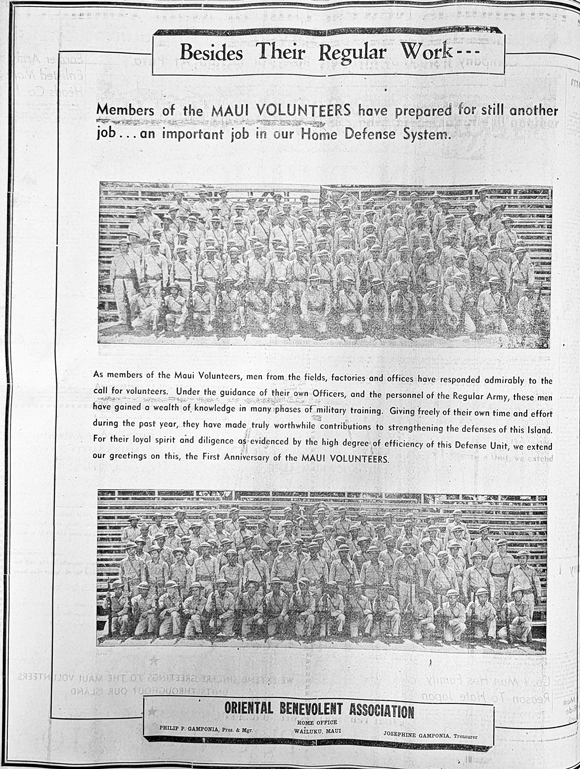
Photo courtesy Maui News archives
Oriental Benevolent Association’s ad, president and Manager Philip P. Gamponia with Treasurer Josephine Gamponia stated: As members of the Maui Volunteers, men from the fields, factories and offices have responded admirably to the call for volunteers. Under the guidance of their own Officers, and the personnel of the Regular Army, these men have gained a wealth of knowledge in many phases of military training. Giving freely of their own time and effort during the past year, they have made truly worthwhile contributions to strengthening the defenses of this Island. For their loyal spirit and diligence as evidenced by the high degree of efficiency of this Defense Unit, we extend our greetings on this, the First Anniversary of the MAUI VOLUNTEERS.
The spirit of the Maui Volunteers became a unifying call for the community. The Maui Volunteers were ready to act—as one advertiser described—as “Minute Men” to defend Maui—all without any compensation.
Fortunately, the Maui Volunteers were not activated. There was much excitement when General Douglas MacArthur returned to the Philippines on October 20, 1944 and eventually Manila was freed from Japanese occupation.
In celebration of Manila’s liberation, a parade was held on Sunday, February 11, 1945 from the Wailuku ballpark to Wells Street to Market Street to Vineyard Street and back to the park. In addition to the parade, booths for war bond sales and collection of clothing for the Philippines were set up. The general chairperson of the affair was Gamponia. His various committees and committee members included: Program and Invitation: Demetrio Gamponia, Canuto Tacderan, Rafael Cabebe, Asisclo Sevilla, Napoleon Agasid, Florendo Felipe. War Bond: Napoleon Agasid, Nick Barbosa, Nick Domingo, Charles Cabe, Tomas Quizano, Crispin de Lara, Rev. B.T. MaKapagal, Rev. R. Barrientos, Bernardo Aquiat. Parade: Charles Cabe, Nick Domingo, Bernardo Aquiat, Nick Barbosa, Florendo Felipe, Juan Quiocho, Lucio Nefulda, Fern Fidelizo, Julian Rania. Display and Decoration: Rev. E. A. Centeno, Juan Alvares, Nick Barbosa, Agapito Palafox, Calixto Torqueza, Leon Arquero, Napoleon Agasid, Tomas Quizano, Hermenegildo Lamadora. Publicity: Rev. B.T. MaKapagal, Demetrio Gamponia, Basilio Acebedo, Rafael Cabebe, Teodorico Samonte. Entertainment: Mrs. Feliza Centeno, Mrs. Mary MaKapagal, Mrs. Mercedes Serra, Mrs. Felicidad Quiaoit, Miss Pastoria Domingo, Miss Conchita Balderas, Miss Annie Villegas, Miss Maxima Balmores. Clothing and Relief: Mrs. Feliza Centeno, Mrs. Mary MaKapagal.
The entire regiment of Maui Volunteers marched in the parade and over $27,775 worth of War Bonds were raised.
In mid-June 1945, the Army announced the release of all ten regiments of the Organized Defense Volunteers, including the Maui Volunteers, effective July 4. The various units held parades and lū‘au. The last lū‘au was held by Company B at Pioneer Mill in early October 1945.
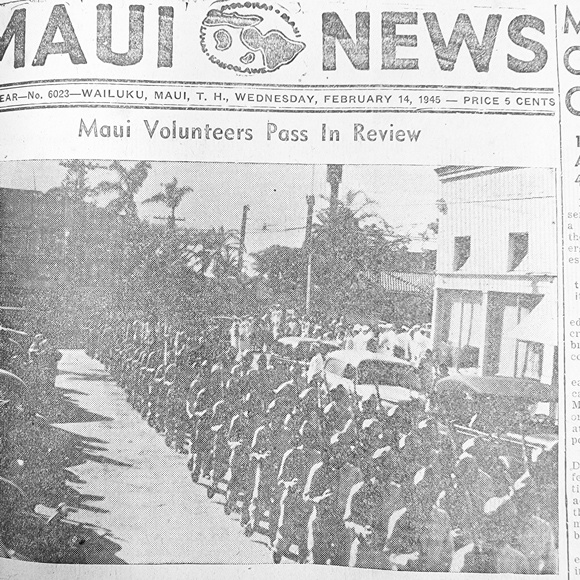
Photo courtesy Maui News archives
On the last official date of the Maui Volunteers’ existence, the Maui News printed an Editorial that bears reprinting in its entirety:
Those were critical days here in Maui County, following December 7, 1941, when we didn’t know the exact whereabouts of Tojo’s men and our own defense forces hereabouts were few and far between.
At that time there were hundreds of local men who were willing to fight but who were employed in essential industry that mean much to our country’s war effort. Some of these men had had previous military training.
No man had a better insight into the picture at hand than did Col. Charles B. Lyman, Maui District commander at that time. As a result of Col. Lyman’s untiring efforts the 1st Regiment, Maui Volunteers was formed among Maui’s men employed in essential industry who were willing to defend these shores, if need be. They took an oath to the effect that they would be sworn into the Army of the United States if necessary.
Then began the long fight by Col. E. Percy Lydgate, commanding officer of the Maui Volunteers, to secure equipment for these men to properly prepare themselves in the art of war.
Some of the Filipinos did not wait for Uncle Sam to supply equipment but went ahead and made themselves bolo knives which were the envy of regular army troops who arrived here in early 1942.
Every district commander was enthusiastic in his praise of the Maui Volunteers, while everytime the Volunteers went on maneuvers with the regular army units they conducted themselves creditably.
Praise is also due to the wives and families of the Maui Volunteers who gave up many a Sunday and evenings when husband or daddy would ordinarily have been at home with them.
Now the war has progressed to the stage where the army feels there is no longer a need for the services of the Organized Defense Volunteers in the Islands. For this we are thankful.
The community owes a vote of thanks to these officers and men who comprised the Maui Volunteers. In them we have the nucleus of a trained force of officers and men if need for their services should arise again.
Well done, 1st Regiment, Maui Volunteers.
It was indeed well done. While the memory of the Maui Volunteers will continue to fade with the passing of time, their volunteer service will perhaps never be repeated.
And yes, The Fil-Am Voice is the first to call for a monument to honor them.
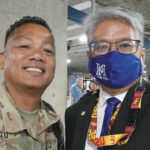 Alfredo G. Evangelista is the Assistant Editor of The Fil-Am Voice. Although he never served in the armed forces, he is grateful to have Veterans in his family, including his late brother Sgt. Rogelio Evangelista and his first cousin Staff Sgt. Jimbo Evangelista, who is in the photo with him.
Alfredo G. Evangelista is the Assistant Editor of The Fil-Am Voice. Although he never served in the armed forces, he is grateful to have Veterans in his family, including his late brother Sgt. Rogelio Evangelista and his first cousin Staff Sgt. Jimbo Evangelista, who is in the photo with him.
